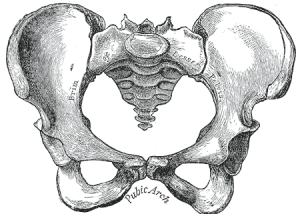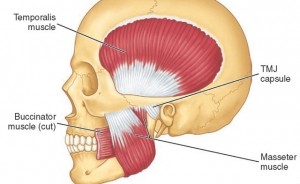Last week I wrote about the masseter muscle that connects the jaw to the skull. If your jaw aches odds are the masseter is involved. Likewise, the masseter is by nature involved when people suffer from jaw dysfunction commonly referred to as TMD, or TMJD. It isn’t the only muscle in the mix so you will be feeling all the involved muscles of the jaw in the exercise below.
This is the umpteenth, The Pelvis, The Psoas and… And not to beat on a dead horse for the umpteenth time but…
The alignment of the pelvis (and the legs underneath the pelvis), determines in large part the alignment of the psoas. Together these two partners when we’ll situated, facilitate ease in the body both postural and emotionally.
Well situated for me means that the leg bones fall directly underneath the hips and your big butt muscle gluteus maximus doesn’t sit on the hamstring. It should have a room of its own, so to speak, and that is one way to know that your pelvis is in a good neutral position.
 The psoas is in a good position when the bottom of it, where it attaches to the back of the femur bone, is aligned with the back half of the body.
The psoas is in a good position when the bottom of it, where it attaches to the back of the femur bone, is aligned with the back half of the body.
The opposite, where I think most people spend the majority of their time, is for the thigh bones to sink or lean forward which forces the gluteus maximus to sit down on the back of the thigh or hamstrings. This also moves the attachment of the psoas to the front half of the body.
For the following exercise I want you to switch back and forth between these two positions. Feel free to go to extremes in both directions. The point is to feel the muscles of the jaw and how they respond to the different ways the bones align when you shift the pelvis from tucked under to stuck out.
I think that there is a correct or best alignment of the pelvis and psoas. I believe that you know that you are there when the majority of your muscles relax when not in a state of action. In this case we are feeling the masseter and muscles of the jaw.
This is an experiential exercise that is hopefully pretty easy to tap into, and very easy to do.
Feel the Masseter and the Jaw
- Stand with the feet as close together as comfortable and towards parallel.
- If it is comfortable, close your eyes.
- Start by standing in a position that you consider good posture.
- Bring your awareness to your jaw. How does it hang? Do the muscles feel tight? Loose? Etc.
- Now lean the thighs forward and tuck the pelvis under keeping your awareness on the jaw and how changing your posture changes your jaw.
- Then stick your butt out and take the thighs back (though you can do this in any order that you’d like).
- Move back and forth this way feeling the changes in tone to the jaw and its assorted connective tissue.
- Find the placement of the pelvis where the jaw and masseter muscles feel best.
If I had to guess the legs will be under the hips, the gluteus maximus will have a room of its own and your psoas will be set back at is base so that it can perform its magic.



